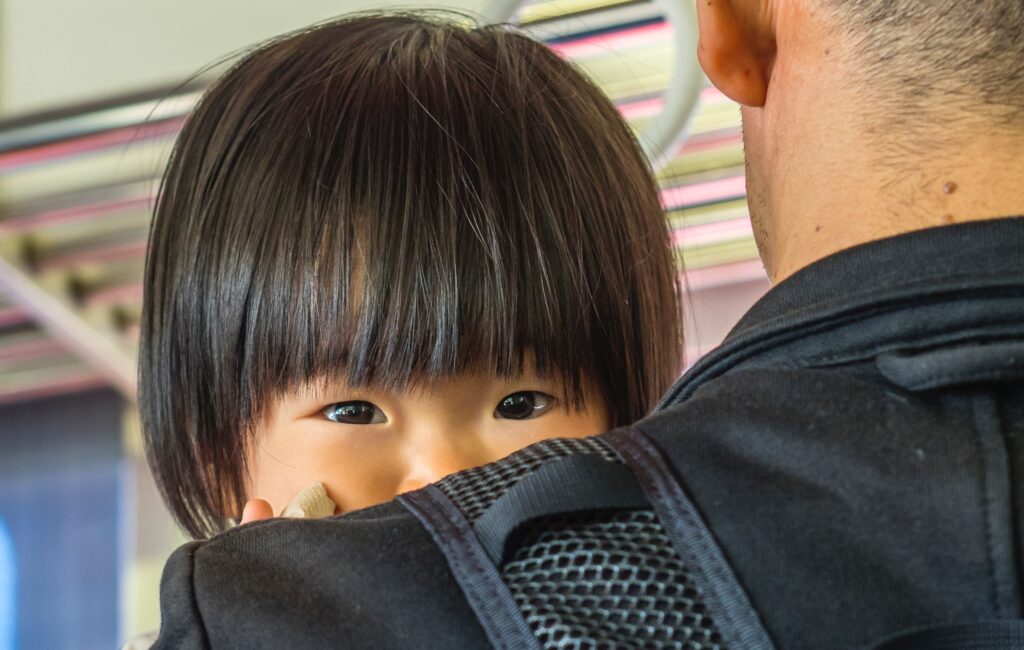
Parents often have troubles to “transfer” their infant/toddler/preschooler to another caregiver, such as the other parent, grandparent, nanny or kindergarten teacher. The child protests, cries and clings to us and we find ourselves helpless in front of this wave of emotions. Most of us know intuitively that this behaviour is normal when we try to leave the child with someone he/she is not attached to. But why does it happen when the child is attached to the caregiver but still won’t stay with him/her? And what should we do in that case?
Small children are attachment creatures – they need to always be in the presence of someone they are attached to. But they absolutely are not able to hold on to two people simultaneously. Hence if the caregiver whom they are feeling the connection to at the moment is leaving, those kids are feeling abandoned, which evokes in them huge feelings they are absolutely are not able to stop. It’s their normal survival instinct that pushes them to be alarmed, to cling to us or to try to make us stay at any cost. To help the child with the transition process we need to switch the attachment context – to activate the connection with the caregiver that stays with the child.
What I usually do with my kids is a 3 steps “dance” to move the attachment context of a preschooler from me (caregiver A) to caregiver B, that helps them to cope with the transition. It works if the child generally has an attachment to caregiver B, and it “just” needs to be activated.
1. Caregiver A matchmakes caregiver B to the child.
Basically he/she needs to send the child the message – “I trust caregiver B to take good care of you, and you will be fine with him/her”. For example: “You know who is absolutely the best in playing hide and sick? -It´s daddy! Wait and see- it´s gonna be so much fun with him- you’ll play with trains, feed the ducks in the pond- you’ll have such a wonderful time”. Or another example: “You are staying with Anna – remember?- She’s your favourite teacher! She has the same eyes colour as you! She has prepared some fun activities for you today. Let’s see what you can do with her now….”.
2. Caregiver B collects the child.
a. He/she approaches the child gently, goes down to the his/her height and talks to him, attracting his attention – his eyes or his ears – gently towards oneself by using some small talk, almost the same way we often approach adults: “Hey buddy! How are you doing? Look at you – you have a new shirt today- I love it- i have a similar one at home.”
b. Once caregiver B has the attention, he needs to collect a smile. Any joke or a game, or anything nice he/she can say to the child can be helpful here along with a playful tone. “Who is my sweet honey-bonny?!! Who is absolutely the cutest?!! I will catch my boy now!”
c. After the child had smiled at the caregiver, the later needs a nod, agreement: “Are you ready to play with me?” “Are we going to the park?” “Isn’t the weather fantastic today?
d. After she/he nodes, most probably the child is collected- she/he allows caregiver B to touch his/her hand or to be hugged, or to be picked up by him/her. If not- steps a-d should be repeated.
3. Caregiver A bridges the separation. Even if the child has been collected and has been switched already to caregiver B, it’s important for caregiver A not to leave unnoticed. The child would recall the caregiver A at some point and the fact that the separation hasn’t been bridged and the caregiver just had disappeared into thin air could be very alarming. When bridging, the caregiver doesn’t talk about the separation but rather about the next point of reconnection: “You will play with uncle Will for a while, then you’ll eat lunch together and after lunch I’ll be back! And you can call me whenever you want if you miss me! And here is my shirt/photo that will stay with you this whoooole time!”.
The order of steps 2 and 3 can be interchangeable – we can use our intuition and see what suits the situation more. If after this 3 steps dance the child is able to say bye-bye to caregiver A and to stay with caregiver B without protest – great.
What if despite all of our efforts the child is still crying? We shouldn’t be afraid of child’s tears. She/he can be sad about us leaving. If we know she is in good hands, in warm and loving care of a person she is attached to, the separation from us won’t be traumatizing , it will be just sad. And if caregiver B is able to be there for the child, to support her/him in her feelings, to accept them, to invite her sadness and to provide a shoulder to cry on, our child will be safe. The child would experience some separation in safe hands of caring caregiver, he/she would experience it as something that hadn’t gone as she/he wanted, but still she/he has survived it and she/he was ok after all! That would lead to adaptation on a deep level. The child would be changed from within, gaining the resilience we all wish so much for our kids.
Author: Lina Vizelman
Based on the teachings of Dr Gordon Neufeld.
